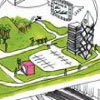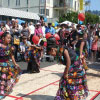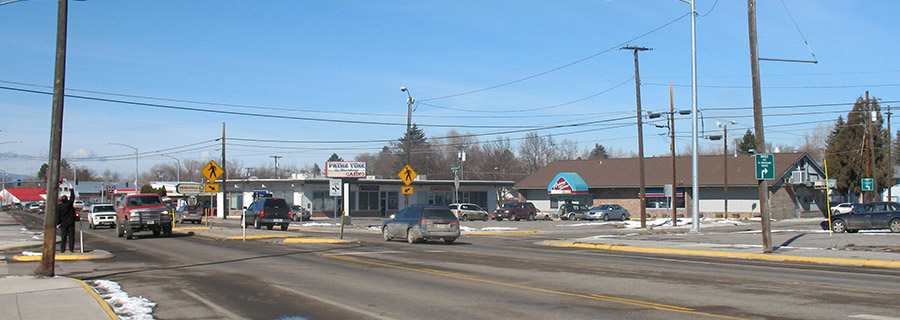
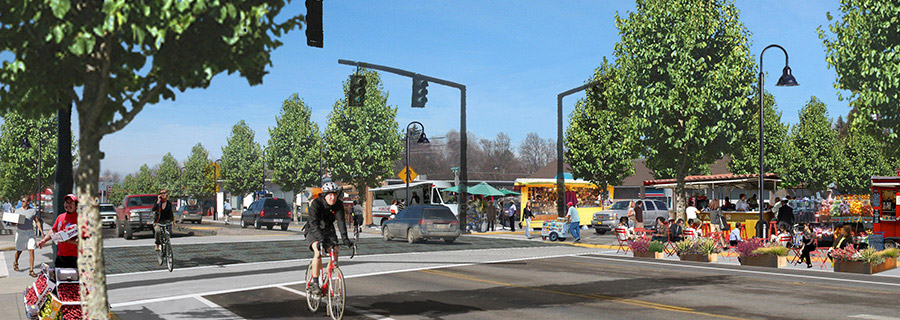

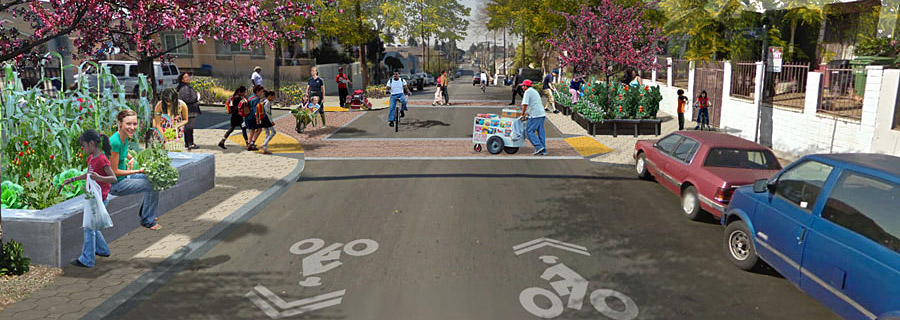
Commerce may be defined as the exchange of goods or services for money or barter. Cities are hubs of commercial innovation, drawing entrepreneurial individuals from all social strata, who seek to make a living through various means despite limited resources. In the United States, commerce usually has been located in the private realm, inside the stores or offices or other privately-owned and operated spaces located at the back of the sidewalk. With few exceptions, where commerce has entered the public realm, it has been relegated to that slip of land on the sidewalk between the buildings and the pedestrian travel way. This land is the usual habitat of outdoor dining, sidewalk sales, or newspaper vending machines.
By expanding our vision of streets, by opening our minds to the possibility of commerce anywhere, we can capitalize on the numerous types of entrepreneurs and commerce that can thrive in the public realm, and thereby help improve the economic health of both cities and their inhabitants.
Placemaking Is Critical for Successful Commerce
Today more and more shoppers want a rich, experiential setting in which to shop—a place that is attractive and lively, a place that creates a long-lasting positive memory. This desire for a high-level experience is particularly relevant when we think about the miles and miles of arterial and high speed roadways that make up much of the American landscape, many of which are intended to connect shoppers and business people to commerce.
Many upgrades to the shoppers experience can be made within the area historically used for commerce, such as main streets, where the existing system of sidewalks, parking areas, and private development help create the necessary framework for active commerce. However, the arterial roadways should also be considered as an area where commerce can happen in these roadways also, while people can use alternatives to the car to move through these routes, such as transit, cycling, and walking.
Neighborhood identity and placemaking should draw on inspiration from a particular local industry, art, music, or area theme that makes it a distinctive destination. We can address these issues and opportunities creatively to empower public and private sector decision-makers by furnishing the tools for design transformation.
The Need for Commerce
Commerce is an essential component for all cities. It is the engine that drives economic prosperity. An economically healthy city attracts residents and investment, while an economically weak or distressed city struggles with crime and disinvestment. Because commerce creates jobs, it can be an engine for social improvement, job creation, housing development, and other instruments of stability that allow residents of all income levels to achieve long-term financial stability. Furthermore, cities increasingly rely on private commercial activity and the tax revenue it generates, to provide citizens with basic services, including sewer systems, trash removal, and street cleaning, as well as libraries, parks, or social service programs.
Including a variety of commerce types opens opportunities for a variety of entrepreneurs, from the fledgling business owner to well-established businesses. Accommodating these commerce types in a range of locations increases the area allowed for commerce, which improves the street’s overall character. The result is an environment that fairly hums with commercial activity and the promise of prosperity. This increased entrepreneurial energy creates a mutual support system by which all businesses have the possibility of increasing their customer base. People are attracted by one business, or sometimes they are just attracted to an area where they can “see and be seen,” and the result is that other businesses also improve, providing new jobs and growth opportunities for all.
Streets designed for commerce should aim to meet the following overall goals:
- Maximize economic development at varying types and scales (single owner/operator, small businesses, companies).
- Create an identity and sense of place to strengthen the commercial street as a singular destination.
- Provide a strong connection between the public realm (the public right-of-way, including streets and sidewalks) and the adjoining land uses in the private realm.
- Allow mixed use and “extreme” mixed use for character building and distinction.
- Animate and mitigate ‘blank’ edges of the adjoining private realm.
- Capitalize on underutilized and ‘residual’ spaces that are traditionally devoted to mobility.
- Encourage entrepreneurial spirit by allowing individual action and customization.
- Create street life and increase foot traffic.
- Improve design aesthetics.
- Stimulate all five senses.
- Reduce impacts of vehicular traffic through circulation planning and design.
- Engage local artists in placemaking activities.
- Address personal safety and security.
- Design for year round comfortable, multi-seasonal use.
Streets for commerce should be designed to include a diversity of activities including but not limited to:
- Buying and selling
- Displaying merchandise
- Exchanging/bartering
- Negotiating/bargaining
- Browsing, window-shopping
- Manufacturing/producing - cooking, sewing, painting, etc.
- Consuming - eating, drinking, etc.
- Performing
- Demonstrating products
- Offering services
- Cleaning and maintaining
- Interpreting local history and culture
- Teaching and learning specific skills
- Socializing and meeting other people
- Connecting with social media
The following commerce types should be supported and facilitated through the design of the street environment:
- Traditional commerce comprises the activities we are used to seeing on the street that support the commerce of adjacent bricks-and-mortar businesses. Book or product displays, outdoor dining, and sidewalk sales are all examples of traditional commerce types. Educational and learning laboratories as well as open studios can also be considered here.
- Stand-alone, permanent commerce comprises those business activities that are independent of the adjoining bricks-and-mortar establishments. Newspaper kiosks, vending machines, and vendor niches, are examples of stand alone, permanent commerce.
- Temporary/mobile commerce comprises activities that are not physically integrated with the private realm. Food carts, ‘taco trucks’, lemonade stands, horse-drawn carriage or cart rides, performances, open studios, and special events are all examples of temporary/mobile commerce.
These commerce types can be accommodated in a variety of locations within the street or public right-of-way, such as sidewalks, plazas, bulbouts, parking lanes, medians, or travel lanes. These locations are traditionally given names that tend to designate them as single use elements, but when designing streets for commerce, they should be considered multi-use spaces. For example, in some areas “parking lanes” might be designated for parking only, while in others they might sometimes be for parking and other times for temporary retail carts or food vendors. In places that can be readily accessed without cars, this traditional “parking” zone might be permanently dedicated to other uses like commerce, social gathering, or play.
A combination of elements and amenities are essential to street commerce design. Some support business activities themselves, and some provide a comfortable environment for customers.
- Seating, both fixed and movable, including stairs, should be made of materials that are long-lived, require minimal maintenance, and provide a comfortable seating surface.
- Shade providing elements (shelters, trees, tents, etc.) should be provided to protect both customers and sales staff from the elements.
- Lighting is a key element to provide nighttime visibility, as well as a sense of security. It can also be designed to enhance a location’s mood or character.
- Public Restrooms or comfort stations could be either permanent of temporary in nature.
- Lockable permanent kiosks and stands allow vendors to maintain products on site during off hours, minimizing their “store” opening and closing operation. These spaces can take many forms, including nooks against the building with lockable doors or screens, separate kiosks with locking panels, or lockable boxes, such as the “bouquinistes,” used by French booksellers along the Seine.
- ‘Liner retail’ are lockable permanent kiosks and stands along the edge of the private parcel. They can be designed as part of the building structure or creatively added on along a usually inactive or blank edge of the building.
- Movable carts are the heavy lifters of street commerce. They can carry everything a business owner needs, from display space, seating, and cash registers, to the many varied instruments of product development, such as refrigerators, griddles, sewing machines or potter’s wheels. They can move with the seasons and change with the market, be everything for the “little guy” entrepreneur or one of many tools for the “big guy.”
- Trash receptacles are essential to maintain cleanliness, not only to meet health department regulations, but also to ensure the location’s continued attractiveness to the widest customer base.
- Water sources must be included for cleaning and maintaining the physical environment; cooking, handwashing, or other business use; for drinking water; and for any public restroom connections.
- Power sources are essential in a variety of forms to accommodate a range of equipment, such as speakers or other electronic gear used by performers, cooking equipment, temporary lighting, computers or other dataports, etc.
- Grease traps, sewer drains, and stormwater catchment areas must be included to support the refuse created by any food production as well as maintaining the physical environment.
- Wi-fi (or other mobile information sources) is an integral part of modern business, and is not only a useful tool for customers, who want to log-on and get information about businesses in the area, but it is also useful to business operators, who need on-line access to update product ads, “tweet” the latest event announcements, or even access financial information.
- Performance spaces and artistic displays contribute to space activation and sense of place.
- Outdoor teaching and learning stations encourage social interaction and creativity.
- Tables encourage a variety of behaviors including eating, gaming, meeting, working, etc.
- Wayfinding signage is critical in all commercial districts, especially in densely packed markets.
- Parking and access for bicycles, autos, and delivery trucks should be located strategically along the commercial street.
- Pedestrian ways should be designed to allow clear circulation.

